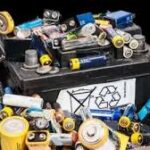As the global transition to clean energy accelerates, the demand for lithium-ion batteries is projected to surge exponentially. By 2030, over 2 million metric tonnes of batteries will be retired annually, requiring a robust ecosystem for recycling and reuse. At LOHUM, we are leading the charge in sustainable battery solutions, closing the loop on Critical Minerals while pioneering innovative lithium-ion battery second-life applications.
The Growing Need for Battery Recycling
With electric vehicle (EV) sales climbing rapidly—over 50% of modern EVs have been sold in just the past two years—the need for an efficient recycling and second-life strategy is more crucial than ever. Traditional mining operations cannot keep pace with the demand for lithium, cobalt, and nickel, necessitating alternative material sources. Recycling and repurposing retired batteries significantly reduce reliance on virgin resources, alleviating environmental concerns related to mining, such as water depletion and toxic runoff.
Today, large-scale lithium battery recycling facilities primarily rely on pyrometallurgical (smelting) processes, which operate at temperatures exceeding 1500°C. While effective at recovering nickel, cobalt, and copper, these methods are energy-intensive and often fail to reclaim lithium and aluminum efficiently. Hydrometallurgical techniques offer an eco-friendlier alternative, utilizing leaching chemicals to recover valuable materials with lower energy input and emissions. LOHUM is at the forefront of advancing these methods to ensure high-efficiency material recovery while minimizing environmental impact.
Unlocking Second-Life Potential
According to the US Advanced Battery Consortium, an EV battery reaches the end of its primary life when its capacity declines below 80%. However, these batteries still retain significant storage potential, making them viable for second-life applications such as grid storage and renewable energy backup.
Studies indicate that repurposed EV batteries can serve in stationary applications for an additional 6–10 years. This extends their usability while reducing waste and lowering the overall carbon footprint of battery production. LOHUM is pioneering lithium-ion battery second-life applications, leveraging advanced diagnostics and AI-driven analytics to optimize battery repurposing for energy storage solutions.
The Future of Critical Minerals and Battery Sustainability
Recycling batteries not only mitigates the environmental impact but also enhances supply chain security. More than 60% of the world’s cobalt originates from the Democratic Republic of Congo, where mining practices raise concerns about human rights and environmental degradation. By recovering Critical Minerals from retired batteries, we reduce dependency on volatile global supply chains and promote ethical sourcing.
Recent research has demonstrated that direct recycling methods can yield cathode materials that perform as well as, or even better than, those derived from virgin materials. These advances present an enormous opportunity to improve battery performance while significantly cutting costs. LOHUM is committed to driving innovation in sustainable battery material recovery, creating a circular economy for lithium-ion batteries.
Policy and Industry Collaboration for a Greener Future
As California moves toward ensuring 100% recycling of EV batteries, similar policies worldwide will play a pivotal role in shaping the industry’s future. Standardization, infrastructure development, and investment in advanced recycling technologies will be essential for closing the loop on battery materials.
LOHUM is dedicated to revolutionizing battery sustainability through cutting-edge recycling, repurposing, and material recovery innovations. By harnessing state-of-the-art technologies, we are creating a future where every battery contributes to a greener, more sustainable world.
Visit us at: reverse logistics for lithium-ion batteries
Originally published on: Blogger

